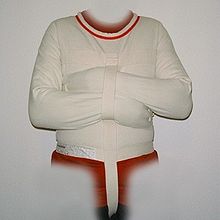Straitjacket
The straitjacket is a jacket used to restrain a person in medical use, i.e. to fix a patient .
development
In 1790, straitjackets are said to have existed in the asylum of Bicêtre , made by an upholsterer named Guilleret . The jacket known today comes from the "father of American psychiatry", Benjamin Rush , in the 19th century. Since then the straitjacket has been used in so-called insane asylums . The use of straitjackets used to result in head injuries when patients were not kept in a padded cell because the patients hit their heads against the wall. Straitjackets were previously used in psychiatry, but - at least in Germany - they are no longer used. In the 1960s and 1970s, these jackets were euphemistically referred to as protective jackets in many mental health facilities .
use
The straitjacket represents a form of medical fixation. The arms of the person to be fixed are put into the sleeves of the straitjacket, which have no opening at the end. The straitjacket is then first closed on the back by closing and tightening numerous straps, the straitjacket is therefore tight against the upper body. Then the arms are crossed in front of the upper body. Most modern straitjackets now have a loop on the front through which the sleeves can be pulled; there are also loops on the sides of the jacket. This is to prevent the arms from being pulled over the head. First, so that the fixated person cannot break free and second, so that the person cannot strangle himself if the sleeves got caught on his neck. At the end of the sleeves there is a belt and a buckle, which are led to the back and connected there. So that the restrained person cannot pull the straitjacket over their head, many straitjackets have an additional strap, the so-called crotch strap, which is pulled back between the legs and tightened on the back like the other straps. The straitjacket does not affect the freedom of movement of the legs;
The fixation with the straitjacket looks relatively comfortable at first glance compared to other restraints. To prevent the handcuffed person from freeing themselves, the straitjacket must fit snugly. This is achieved in that the size of the jacket fits the person who is to be fixed with it. Using a jacket that is too small hampers breathing, which can lead to serious physical and psychological disorders, as the fixed person cannot help himself.
A straitjacket that is too big would make it easier for the restrained person to free their arms. Here, too, the arms are bent against the body, which can be very painful in the long run due to the position and the inability to stretch out the arms. Choosing the right size also makes a decisive contribution to "wearing comfort". Depending on the material used, it can get very warm in the straitjacket - the tied person begins to sweat profusely in the long run.
In the medical field, the wearer of a straitjacket is therefore not fixed in it without regular checks.
Manufacturer
The only remaining manufacturers of straitjackets in the medical field are Humane Restraint and Posey, both based in the United States. Posey stopped producing straitjackets (model number 8118) in 2017, which is probably due to the ever-decreasing use of the straitjacket as a fixative.
Straitjackets in BDSM
In the BDSM and bondage scene, straitjackets are used, among other things, to fix the bottom . The design (especially many buckles, narrow neckline) and material ( latex , leather) are often adapted and manufactured for these purposes.
Web links
Individual evidence
- ^ Paul Bru: Histoire de Bicêtre (hospice, prison, asile) d'après des documents historiques . Progrès médical, 1890.
- ^ Emil Kraepelin : Hundred Years of Psychiatry: A Contribution to the History of Human Morality, 1918. Reprinted by Springer-Verlag, 2013, ISBN 978-3-662-25566-7 . For a detailed description of the use of straitjackets and forced beds, p. 8ff.
- ↑ Volker Renz: Health and Disease Theory, Care: A training and practical book for Heierziehungspflege , Kohlhammer Verlag, 2012, ISBN 978-3-17-021338-8 . Cape. 5.8: Legal basis and practical application of restraint p.


